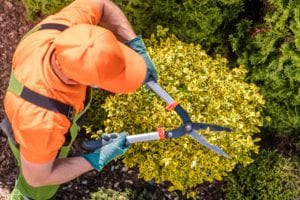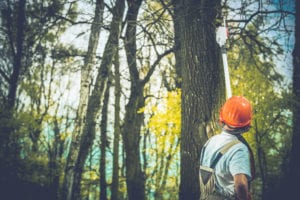If you have lost a tree to disease, you know exactly what kind of hole it leaves in your landscape. Yet most homeowners often do not recognize the early signs of distress until it’s too late.
This article will help you—and your trees—avoid that fate. From Dutch Elm Disease to Apple Scab, we will cover ten of the most common tree diseases, including signs to look for and how to treat your trees (as well as when to call an arborist). So, grab your gardening gloves and let’s get started.
Common tree diseases
Dutch Elm Disease
This fatal fungal disease, spread by elm bark beetles, affects elm trees—and has decimated many of the beautiful parkway elms in the Chicago area. Look for signs of wilting and yellowing on leaves.
Treatment
- Prune infected branches—and destroy immediately, away from elm trees
- Protect healthy trees with application of fungicide injections
- Monitor elm bark beetles to prevent spread
Apple Scab
As its name suggests, this fungal disease affects apple trees. It causes dark, scaly lesions that damage twigs, leaves, and fruit. Apple Scab spores overwinter in fallen leaves and fruit.
Treatment:
- Rake and remove fallen leaves and fruit to reduce overwintering spores
- Protect new growth by applying fungicides during the growing season
Anthracnose
This group of fungal diseases affects a wide range of trees, including dogwoods, maples, oaks, and sycamores. Symptoms include evidence of leaf spots, twig dieback, and cankers, which are patchy dead or ailing areas on tree bark.
Treatment
- Prune and destroy affected branches
- Reduce risk (and improve tree health) with proper watering and fertilization
- Apply fungicides during outbreaks
Fire Blight
Caused by bacteria, this disease affects fruit trees including apple, pear, cherry, and hawthorn. Look for wilting, blackened shoots, and cankers.
Treatment:
- Prune infected branches at least 12 to 18 inches below visible evidence
- Apply bactericides during bloom
- Reduce risk (and improve tree health) with proper watering and fertilization
Oak Wilt
Oak wilt is a fungus affecting oak trees, especially red and white oaks. It causes leaf discoloration, wilting, and death.
Treatment
- Remove and destroy trees with oak wilt—including the roots—to prevent spread
- Avoid or prevent root grafting between healthy and infected trees
- Protect healthy trees with fungicide injections
Sudden Oak Death
Caused by a pathogen (Phytophthora ramorum), Sudden Oak Death results in leaf browning and twig dieback. As its name suggests, it can be fatal.
Treatment
- Remove and destroy affected trees and plant material
- Control spread by minimizing movement of infected plant material
- Protect healthy trees in high-risk areas with fungicide application
Pine Wilt
Pine wilt disease affects various pine tree species. It is caused by a type of roundworm called a nematode, which is transmitted by the pine sawyer beetle. It causes rapid wilting, browning of needles, and tree death.
Treatment
- Remove and destroy infected trees
- Proactively apply insecticides to healthy trees to control pine sawyer beetles
- Replant affected areas with less susceptible tree species
Cedar-Apple Rust
Cedar-Apple Rust is a fungal disease that preys on apple and cedar trees, causing orange rusty lesions on apple trees, and cedar galls on cedar trees. A cedar gall is an abnormal growth, like a tumor. Cedar-Apple Rust will lead to tree decline and can be fatal.
Treatment
- Control spore production by removing cedar galls from cedar trees
- Apply fungicides during outbreaks
- Choose resistant apple tree varieties
Chestnut Blight
Also caused by a fungus, signs of this blight affecting chestnut trees include cankers and wilting. Chestnut blight is eventually fatal to trees.
Treatment
- Prune infected branches and cankers
- Destroy prunings
Diplodia Tip Blight
This fungal disease affects pine trees. Look for dieback of new shoots, cone damage, and cankers weeping resin.
Treatment
- Prune and destroy affected shoots
- Apply fungicide during active periods of disease
Proper tree care goes a long way toward protecting your trees because a healthy tree is less susceptible to infection. Proper tree care includes regular watering and fertilization during growing seasons, as well as pruning in the right way at the right time (hint: winter is an ideal time for pruning, as trees are dormant). Not sure what species of tree you have? Proper identification goes a long way toward providing the right care. Apps like PictureThis can help you with identification. Consult a local arborist or tree expert for specific information and care tips.
Even if you do notice signs of leaf wilt or leaf spots, cankers, or other symptoms of disease, early intervention can go a long way toward saving your tree. Make it a habit to regularly inspect your trees while watering. If you notice something unusual, reach out to a tree expert for more information.
We can help. Advanced Tree Care combines top-notch equipment, cutting-edge technology, and well-trained staff to provide emergency tree removal and tree maintenance services. With a presence in nine counties and two states, we work daily to provide unparalleled customer service, safety, and efficiency—as well as the expertise to beautify your landscaping and community. Advanced Tree Care isn’t just our name—it’s also our purpose!



